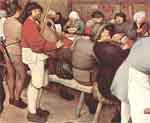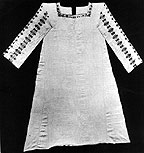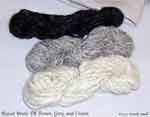

![]()

(formerly: CIRGA Costume Guidelines, Part 1)
By Kimiko Small,
© June 2007, http://www.kimiko1.com
[Editing Note: Parts 2 & 3 were never written before
CIRGA was disbanded in January of 2008. I may write them later.]
This is part one of a series of articles that will expand upon the CIRGA costuming guidelines, as provided on the CIRGA web site. It is my hope to clarify the guideline of each of the stated classes, and give more insight and offer more historical suggestions, based on the historical basis behind the guidelines.
Basic Peasant Dress
To clarify in English society of the 16th century, the peasant class would consist of the least sorts of people, yet the ones most common in number. “The fourth and last sort of people in England are day-labourers, poor husbandmen, and some retailers (which have no free land) copyholders, and all artificers, as tailors, shoemakers, carpenters, brickmakers, masons, etc.” (Harrison, 1577, Chapter 1)
In the CIRGA guidelines, the suggested garments for men are (from head to feet): Cap (muffin or flat), shirt, jerkin, trews, stockings (if trews end above or just below knee), and shoes. For women it is: Cap (muffin, flat or scarf) , shirt or chemise, bodice, 2 skirts, stockings (if ankles show) and shoes. I will cover men first, with some general info for both sexes, then women's specifics, and then general notes. Children generally are miniatures of their parents (except for the youngest), so I won't cover them specifically here.
 Caps
and Hats
Caps
and Hats
A cap or head covering of some sort was required for everyone, even the children, although they can get away socially with not wearing one at times (although hats are good at protecting their heads from the sun). Hats were worn partly because of the weather, as a hat or cap will keep your head warm during the winter, and shade your head from the sun in the summer. They were also worn for religious and social reasons, and even for matters of fashion. Yes, even the peasants tried to follow fashion, even if they were a bit behind the fashions of London. In fact, the commonly seen “flat caps” worn at faire were quite the vogue in London by the 1570s. Flat caps were almost exclusively worn by apprentices, shopkeepers, artisans, and citizens, and was called the 'City flat-cap'. They were out of fashion among the nobility by then.
I am not fond of the “muffin” caps often seen at faire. Yes, they are easy to make, but I am not finding any images of their use during the English renaissance. Men should at least wear a flat cap, and women wore linen coifs, or simple 'yard cloths' which are linen squares arranged in various styles. Flat caps for women were not seen worn alone, but worn over a linen cap or coif. Men might wear a coif under their hat. Straw hats were also worn by both sexes.
Shirts and Smocks
 The
shirt or smock is the most basic staple of any person's wardrobe. Only
the very poor had only one shirt or smock. Most people had three at least,
and more if they could afford them. All shirts at this level would be
made from linen, in natural, or white if one could afford, of as good
a quality as they can afford (the poorest would afford natural color),
and would be cleaned and repaired on a regular basis. People would sleep
in their shirts, and when dressed for the day, the linen would also keep
the clothing from the dirt, sweat and oils of the body, which is why it
was important to own more than one (one to wear while you washed the other,
with perhaps one as a spare).
The
shirt or smock is the most basic staple of any person's wardrobe. Only
the very poor had only one shirt or smock. Most people had three at least,
and more if they could afford them. All shirts at this level would be
made from linen, in natural, or white if one could afford, of as good
a quality as they can afford (the poorest would afford natural color),
and would be cleaned and repaired on a regular basis. People would sleep
in their shirts, and when dressed for the day, the linen would also keep
the clothing from the dirt, sweat and oils of the body, which is why it
was important to own more than one (one to wear while you washed the other,
with perhaps one as a spare).
For a man, the shirt is simple rectangles, not very full in size. It was not like the romantic billowy shirt we commonly see at faires today. The shirt was fitted closely to the body and arms, with gussets under the arms to provide room, perhaps gussets near the neck for shaping, maybe a collar, and side slits to allow movement below the natural waist. There may even be side gussets to allow more movement. Shirt fashions changed over the century, but are the basic staple of even a peasant man's simple wardrobe. Shirts were made from linen, ranging from coarse to as fine as the person could afford, and were usually sewn up by the man's wife or other female family member.
 For
the women, the smock (aka shift or chemise) was not the loose oversized
drawstring garment we see worn at faire. Such is the style for the Italian
camicia (even they didn't use drawstrings). The English wore smocks that
were closer to the body, as full garments get in the way of a woman's
work, and are uncomfortable under fitted garments. It was easier to roll
the sleeves up the arms as well for working. There were a few different
styles used; some have a low square neck, while some are fuller, cover
the chest and have collars (like a man's shirt). Like the men, the women
bought as fine a linen as they could afford, maybe in natural or in white
if they could afford it.
For
the women, the smock (aka shift or chemise) was not the loose oversized
drawstring garment we see worn at faire. Such is the style for the Italian
camicia (even they didn't use drawstrings). The English wore smocks that
were closer to the body, as full garments get in the way of a woman's
work, and are uncomfortable under fitted garments. It was easier to roll
the sleeves up the arms as well for working. There were a few different
styles used; some have a low square neck, while some are fuller, cover
the chest and have collars (like a man's shirt). Like the men, the women
bought as fine a linen as they could afford, maybe in natural or in white
if they could afford it.
A good online source for getting a proper smock pattern is Drea Leed's
Elizabethan Smock Pattern Generator.
http://www.elizabethancostume.net/smockpat/
Jerkins and Doublets
The jerkin... well, doublet really is a better term than jerkin. It is my opinion that sleeveless jerkins are a compromise to California heat. On terms, lets agree it is a jacket type of garment. Every man should own one, and wear it. To not wear a doublet is to be considered undressed in public, and hence uncivilized. The only images I've found where the peasants are not wearing a doublet in public, is when they are toiling in the fields, or otherwise working in the heat, such as a blacksmith at work. The images of peasants gathered for social occasions show the men all wearing their doublets, with a few wearing a jerkin over the doublet (with or without sleeves, worn over a sleeved doublet). Another thing to note, is that such doublets mostly appear to have fully attached sleeves. In faire, we use sleeves as an optional accessory, usually not worn, mostly due to the heat of our location and times of the year when we perform. But during the English renaissance, cooler weather and higher latitude meant people were frequently fully covered.
 Trews/Breeches,
Codpieces, and Stockings
Trews/Breeches,
Codpieces, and Stockings
Trews; I prefer the term breeches. The images of this time show most peasant men wearing long breeches, upper and lower parts as one whole garment, like very tight long pants, although they are cut very differently than modern jeans. The breeches were usually attached to the doublet by means of various ties or 'points'. Many images show the men leaving those strings off or hanging loose, but the holes and strings can still be seen. Some peasants are seen wearing a type of short breeches, or short breeches over or attached to lower stocks (lower parts of breeches), although this is uncommon.
Depending on the time frame, a stuffed, shaped codpiece might be worn (codpieces fell out of favor among the nobles during Elizabeth's reign). At the very least, a simple triangular codpiece was worn to cover the front opening, which had no zipper (not having been invented), or may have been tied shut in a few places. Since the shirt usually covered things, gaps were commonly accepted among both men and women.
Stockings were worn differently, depending on what else you are wearing. Some breeches might have integral feet so no stockings were seen. Some might wear stockings over the breeches. Stockings were not worn in place of breeches, at least not in England. Separate “nether stocks”, meaning socks/stockings if made separately, were usually attached to the upper stocks (breeches) by ties or sewn together, so they would work as one unit (men didn't like to pull up their socks then, any more than we do now).
 Bodice
and Skirts
Bodice
and Skirts
A woman's bodice and two skirts as suggested by the CIRGA guideline is usually seen as a multi-color mix and match style of garments, with the bodice separate from the skirts, and wearing optional sleeves. While this makes for a colorful faire, and provides for theatrical interest, it isn't historically appropriate. As one old RPF Northern actor recently told me, the faire board didn't want matching 'blueberry muffins' or 'strawberry shortcakes', so they taught the peasant actors to wear mixed colors.
Historically, some images do show a few non-matching bodice and skirt, but a greater number show the ladies wearing full kirtles, where the bodice and outer skirt are sewn into one complete garment (you won't have to worry about shifting skirts this way). A second petticoat might be worn underneath the full kirtle (and over the smock) for warmth if needed. A woman's doublet (jacket with attached sleeves) is sometimes seen worn over the kirtle, and it may be matching or of a different color. And most peasant women wore sleeves of one type or another, usually contrasting to the kirtle, when they were dressed in their 'best', usually on Sunday, but perhaps to impress their local gentlewoman on wash day. Or perhaps when simply cold.
Shoes.
Not much to say about shoes, other than finding a good simple shoe, lightly padded with arch support is worth paying for or making yourself, as your feet will thank you after a long day at faire. Shoes in history are a bit out of my league, so I defer to one well known for his historical shoe info, I. Marc Carlson (http://www.personal.utulsa.edu/~marc-carlson/shoe/SHOEHOME.HTM).
Other Notes on Garments and Fabrics
 According
to Ninya Mikhaila (The Tudor Tailor workshop in Vallejo, CA on June 9,
2007) in their research from wills and other documentary sources, common
folks might have two to three different versions of each garment type
(3 shirts, 3 doublets, etc). The 'Best' clothing would be the most recently
made or purchased from the tailor, or even a used garment salesperson
(a large trade in Tudor times). Best clothing would usually be worn for
Sunday church, or in times they wanted to impress others. 'Middling' clothing
would be about a year old, and 'Worst' clothing would be two years old.
She mentioned about three years was the average life cycle of a person's
garment.
According
to Ninya Mikhaila (The Tudor Tailor workshop in Vallejo, CA on June 9,
2007) in their research from wills and other documentary sources, common
folks might have two to three different versions of each garment type
(3 shirts, 3 doublets, etc). The 'Best' clothing would be the most recently
made or purchased from the tailor, or even a used garment salesperson
(a large trade in Tudor times). Best clothing would usually be worn for
Sunday church, or in times they wanted to impress others. 'Middling' clothing
would be about a year old, and 'Worst' clothing would be two years old.
She mentioned about three years was the average life cycle of a person's
garment.
Linen really is the best fabric to use for shirts and smocks. It wicks moisture and helps keep the body cool, even better than cotton. Even the poor would wear linen shirts, smocks, coifs, and 'yard cloths', of a rough weave and in natural color. On wash day, it was the linens of the household (which would include dish clouts, bed sheets, pillow-beres, and more) that were washed, not the outer garments. Linens would be cleaned, perhaps with a soak in lye, rinsed, then hung out in the sun to dry, either on the grass or on bushes. Linens were then repaired if needed, folded, and put away. In time, linens do get whiter and softer with washings and drying in the sun. Dirty linens were for the poorest of the poor who didn't wash their linens.
Wool was the most common fabric for outer garments such as the kirtle or doublet. While we think of wool as a hot material, lightweight wools such as gabardine or 'tropical weight' are actually very comfortable in the summer, which is why men's suits are made from gabardine (a better wool for people of higher station). Also, if you are near fires for cooking, sparks from the fire will snuff out on the wool, and not continue to burn. A wool apron of black worsted wool (imperfectly dyed) might serve as a peasant woman's “best apron” to wear on Sunday. Chose a simple plain (aka tabby) weave wool. An imperfect dye job will give the right look for a common person.
One article of clothing not mentioned in the guidelines is the partlet. Even common women might wear a linen or wool partlet, simply pinned over the open square neck of their kirtle. A linen shawl, or large scarf (known as a “rail” in period terms) would also serve this purpose. Consider that during Tudor times, sun-block was not invented, fabric did that job of protecting a person's skin from the sun, or biting winds.
 Something
else to note, from comments given by Ninya, is that “russet”
is not the specific brown color as we know it today, but any wool that
is undyed. A russet wool would be a simply woven fabric, usually in plain
weave, in the natural colors of cream, grey, brown or even a dark brown/black
color. Peasants would wear such wools, as close to the sheep as this.
But even so, 70% of the noted kirtles in wills for peasant women were
madder red in color.
Something
else to note, from comments given by Ninya, is that “russet”
is not the specific brown color as we know it today, but any wool that
is undyed. A russet wool would be a simply woven fabric, usually in plain
weave, in the natural colors of cream, grey, brown or even a dark brown/black
color. Peasants would wear such wools, as close to the sheep as this.
But even so, 70% of the noted kirtles in wills for peasant women were
madder red in color.
This covers the major parts for peasant class garments. There is a number of details that I could not cover in this short space, but is well worth doing a little research and reading to improve your looks as a peasant during the English renaissance.
Next time, What did the Merchant Class Wear.
Image reference: Note that most images of peasants come from Flemish, Dutch or German sources. Their are very few images of English peasants.
- Being, Simon (Illuminator). Da Costa Hours, Belgium, Bruges, ca. 1515, http://www.morganlibrary.org
- Greenbug, Hope. “Men's and Women's Work Clothing: A Portfolio of Images”, http://www.uvm.edu/~hag/sca/work/
- Leeds, Drea. “How to Make an Elizabethan Chemise”, http://www.elizabethancostume.net/chemise.html
- Wikimedia Commons. Category:Pieter Bruegel d. Ä., http://commons.wikimedia.org/wiki/Category:Pieter_Bruegel_d._Ä.
Specifically: The Peasant Dance, The Harvest, Peasant Wedding. - Unknown artist, “Field of Cloth of Gold”, Unknown date, but believed to have been created after 1547.
- Unknown artist, 'The Embarkation of Henry VIII at Dover”, Unknown date, but believed to have been created after 1547.
Other Resources:
- Cunnington, C. Willet & Phillis Cunnington. Handbook of English Costume in the 16th Century. Boston: Plays, Inc., 1970. ISBN 0823800814.
- Harrison, William (1534-1593): “Description Of Elizabethan England, 1577 (from Holinshed's Chronicles)”, http://www.fordham.edu/halsall/mod/1577harrison-england.html
- Leeds, Drea. Elizabethan Costuming Page, http://www.elizabethancostume.net/
- Secara, Maggie, Life in Elizabethan England, http://www.elizabethan.org/compendium/
- Mikhaila, Ninya and Jane Malcolm-Davies, The Tudor Tailor: reconstructing sixteenth- century dress, Costume & Fashion Press, 2006, ISBN 0896762556. http://www.tudortailor.com/ . This is an excellent book with current research and information, lots of color images, and patterns for portraying all levels of Tudor society.
http://www.kimiko1.com
Entire website, graphics, and text (unless otherwise stated)
© 2003-2013 Kimiko Small, All Rights Reserved